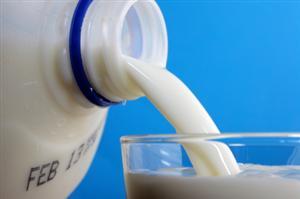| Complexity level: | 7 |
| Project cost ($): | 40 |
| Time required: | 1 hour for preparation, 1 day for experiment |
| Material availability: | Easily available from a supermarket |
| Safety concerns: | Handle hot liquids with care |
Hypothesis
Between low fat milk, powdered milk and soya milk, soya milk will contain the lowest amounts of lactose carbohydrates.
Overview
Milk
Milk is a white colored liquid produced by the mammary glands in mammals, and is used for feeding newborn mammal babies when they are not yet able to digest normal food. Milk contains antibodies which help to protect from many types of diseases, and is hence consumed by humans long after they have outgrown the baby stage. Milk may also be processed and consumed in the form of dairy products.
Milk consists of 87% water, with the rest made up of solids, fats, protein, lactose, minerals and vitamins. Leaving a cup of milk out for a while will cause cream, or milk fat, to form on its surface. Another dairy product, whey, is formed when fat and casein is removed from milk. Casein refers to the proteins in milk, and can easily be separated through the slow addition of acid. Whey is made up of milk salt, sugar and some remaining proteins.
The carbohydrate in milk is called lactose, which consists of glucose and galactose. 4.7 to 4.9% of milk is made of lactose. Mineral salts (sodium, calcium and magnesium) and vitamins (A, D, E and K) are also to be found in milk
Scientific Terms
Materials
The materials required for this science fair project:
- 100 ml of low fat milk
- 13g of non-fat powdered milk
- 100ml of soy milk
- 3 beakers
- 1 hot plate
- 1 thermometer
- 1 bottle 10% acetic acid
- 1 stirring rod
- 12 grams of calcium carbonate
- Water
- 6 pieces of filter paper
- 300ml of ethanol
- 3 Erlenmeyer flask
- 1 digital weighing scale
Procedure
1. For this science fair project, the independent variable is the type of milk used. The dependent variable is the amount of lactose crystals formed, which will be determined by weighing the crystals with a digital weighing scale. The constants (control variables) are the temperature of the environment (which will remain at room temperature), the amount of milk used and the process of extracting the lactose.
2. Label the 3 beakers as milk, powder milk and soy milk. Label the 3 Erlenmeyer flasks in the same way.
3. Pour the low fat milk and soy milk into their respective beakers. In the last beaker, mix 13g of powdered milk into 87ml of warm water. Place the 3 beakers on a hot plate, and bring the temperature of the liquids in the beakers to 55°C. Check the temperatures with a thermometer.
4. While stirring the milk in the beakers, add drops of acetic acid till the liquids turn colourless and a mass of casein protein forms in each beaker.
5. Remove the casein and add 4 grams of calcium carbonate to the remaining clear liquid in each beaker. Stir for a few minutes.
6. Increase the temperature of the hot plate to bring the liquid in the beakers to a boil. Stir the liquid in each beaker with a stirring rod. The remaining proteins will precipitate. Filter the solutions into their respective Erlenmeyer flasks and continue heating until only 25ml of solution is left.
7. Add 100ml of ethanol to the 25ml of solution in each Erlenmeyer flask, and allow to cool. Filter the liquids again. Heat the liquids in their Erlenmeyer flasks, then allow to cool slowly.
8. As the solutions cool, lactose crystals will form in each Erlenmeyer flask. Collect these crystals and measure their weights with the digital weighing scale. Record each measurement in a table, as shown below.
Results
The results show that fresh milk and powdered milk contain almost the same amount of lactose carbohydrate, while soy milk contains almost 3 times less lactose.
| Measurement | Milk type and lactose crystal weight (in grams) | ||
| Low fat milk | Low-fat powdered milk | Soy milk | |
| Lactose crystal weight, gram | 5.3 | 5.4 | 1.7 |
Conclusion
The hypothesis that between powdered milk, low fat milk and soy milk, soy milk will have the lowest lactose carbohydrate content has been proven to be true.
Humans normally consume milk even after outgrowing infancy. We consume milk from other animals like cows, goat and sheep. Milk is also used to produce dairy products like cheese, butter, yogurt, sour cream, chocolates and many others.
Also consider
This science fair project may also be repeated by comparing the lactose content of milk from cows, goats and sheep.
The experiment may also be repeated using different brands of baby formula milk. Also, to improve the accuracy of your results, you should test various brands of the same type of milk, instead of relying on just one or two labels/brands.
References
Milk chemistry - http://www.ilri.org/infoserv/webpub/fulldocs/ilca_manual4/Milkchemistry.htm
Isolation of casein and lactose from milk - http://www.chemistry.mcmaster.ca/~chem2o6/labmanual/expt11/2o6exp11.html
Carbohydrates in milk - http://www.annecollins.com/dietary-carbs/carbs-milk.htm

